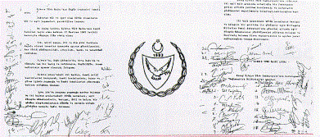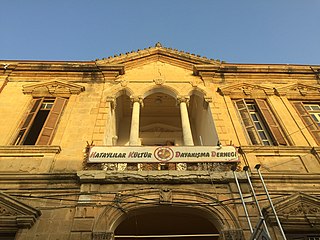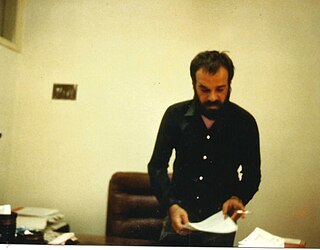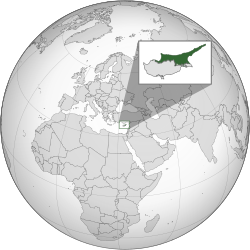
The Cyprus problem, also known as the Cyprus conflict, Cyprus issue, Cyprus dispute, or Cyprus question, is an ongoing dispute between the Greek Cypriot community which runs the Republic of Cyprus and the Turkish Cypriot community in the north where troops of the Republic of Turkey are deployed. The Cyprus dispute's causes stem from Greek ideology Turkish peoples' desire for the partition of Cyprus.

Northern Cyprus, officially the Turkish Republic of Northern Cyprus (TRNC), is a de facto state that comprises the northeastern portion of the island of Cyprus. It is recognised only by Turkey, and its territory is considered by all other states to be part of the Republic of Cyprus.

Rauf Raif Denktaş was a Turkish Cypriot politician, barrister and jurist who served as the founding president of Northern Cyprus. He occupied this position as the president of the Turkish Republic of Northern Cyprus between the declaration of the de facto state by Denktaş in 1983 and 2005, as the president of the Turkish Federated State of Cyprus between 1975 and 1983 and as the president of the Autonomous Turkish Cypriot Administration between 1974 and 1975. He was also elected in 1973 as the vice-president of the Republic of Cyprus.

Mehmet Ali Talat is a Turkish Cypriot politician who served as the president of Northern Cyprus from 2005 to 2010. Talat was the leader of the social democratic Republican Turkish Party, from 1996 to 2005 and 2015 to 2016. He became prime minister in 2004, and subsequently won the presidential election held on 17 April 2005. Talat was inaugurated on 25 April 2005, succeeding retiring leader Rauf Denktaş. He lost the presidential election of 2010 and was replaced by Derviş Eroğlu as President.

The flag of the Turkish Republic of Northern Cyprus is the national flag of the Turkish Republic of Northern Cyprus and is based on the flag of Turkey, with the colors reversed and two additional horizontal red stripes at the top and bottom. The flag was drawn by the Turkish Cypriot artist Emin Çizenel. It was adopted in 1984 by Northern Cyprus, a self-declared state that is recognized only by Turkey, after its unilateral declaration of independence in 1983.

The declaration of Independence of the Turkish Republic of Northern Cyprus was a unilateral declaration of independence (UDI) from the Republic of Cyprus by the Turkish Cypriot parliament on 15 November 1983.

Fazıl Küçük was a Turkish Cypriot politician and a medical doctor who served as the first Vice President of the Republic of Cyprus.

The Politics of Northern Cyprus takes place in a framework of a semi-presidential representative democratic republic, whereby the president is head of state and the prime minister is the head of government, and of a multi-party system. Executive power is exercised by the government. Legislative power is vested in both the government and the Assembly of the Republic. The judiciary is independent of the executive and the legislature.

The Turkish Republic of Northern Cyprus takes place in a framework of a semi-presidential representative democratic republic.

The Constitution of the Turkish Republic of Northern Cyprus was prepared by the Constituent Assembly of Northern Cyprus after the declaration of independence on 15 November 1983, and was approved by the Turkish Cypriot electorate in a referendum on 5 May 1985 with a majority of 70.2% in favour. The constitution is similar to the 1975 Constitution of the Turkish Federated State of Cyprus, but had a number of new provisions regulating the needs of the new Republic. It has 164 articles and 13 transitional articles.
Osman Nejat Konuk was a 2nd prime minister of Northern Cyprus, He held this office twice, once from 1976 to 1978 and a second time from 1983 to 1985.
Mustafa Çağatay was a Turkish Cypriot politician who served as the first Prime Minister of the Turkish Republic of Northern Cyprus from 15 November 1983 to 13 December 1983. He was previously prime minister of the Turkish Federated State of Cyprus from 1978 to 1983.

Turkish Cypriots first issued revenue stamps in 1962 as part of Cyprus; after 1983 of the UDI of Northern Cyprus, the country has continued to issue the stamps to this day.

General elections were held in Northern Cyprus on 20 June 1976. Rauf Denktaş of the National Unity Party was elected President, with the National Unity Party also winning 30 of the 40 seats in the National Council.

Mustafa Akıncı is a Turkish Cypriot politician who was the president of Northern Cyprus from April 2015 until October 2020.

The Autonomous Turkish Cypriot Administration was the name of a de facto administration established by the Turkish Cypriots in present-day Northern Cyprus immediately after the Turkish invasion of Cyprus in 1974.

The Turkish settlers, also referred to as the Turkish immigrants, are a group of Turkish people from Turkey who have settled in Northern Cyprus since the Turkish invasion of Cyprus in 1974. It is estimated that these settlers and their descendants now make up about half the population of Northern Cyprus. The vast majority of the Turkish settlers were given houses and land that legally belong to Greek Cypriots by the government of Northern Cyprus, who is solely recognised by Turkey. The group is heterogeneous in nature and is composed of various sub-groups, with varying degrees of integration. Mainland Turks are generally considered to be more conservative than the highly secularized Turkish Cypriots, and tend to be more in favor of a two-state Cyprus. However, not all settlers support nationalist policies.

Raif Denktaş was a Turkish Cypriot composer, politician, academic, journalist and writer. He died after a controversial car accident where his car collided with a military vehicle.

The Turkish Republic of Northern Cyprus takes place in a framework of a semi-presidential representative democratic republic and is a de facto state that comprises the northeastern portion of the island of Cyprus. Recognised only by Turkey, Northern Cyprus is considered by the international community to be part of the Republic of Cyprus.
















